A few weeks back I attended Culture Hack Scotland 2013 at The Whisky Bond, a mixed art/culture/design space in Glasgow. I was aiming to liveblog the event but ended up too busy with the hack so I’m just finally setting them live now – do let me know if you have any questions or comments about our hack, it would be great to hear what you think!
The event is in it’s third year (my write ups of CHS2011 and CHS2012 are here on the blog) and now a well established part of the Scottish tech events calendar, with developers, techies, designers, and people who don’t quite fit any of those labels (including me) heading along to build something awesome in an intense environment.
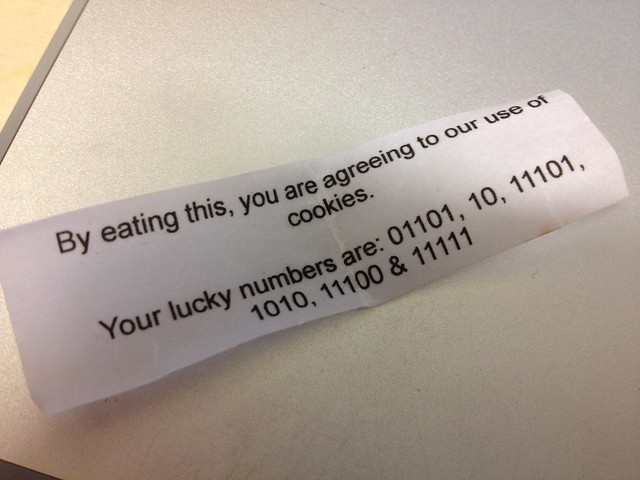
Culture Hack Scotland is not the place for seriousness, behold the awesomely nerdy fortune cookies.
There are very few rules about what you can build at Culture Hack Scotland – as I am typing this post one team are broadcasting a two hour “Live & Hacking” TV show as their contribution to the event for instance – but a range of data are made available from arts and cultural organisations. One of the features of these events tends to be developers supporting each other through their hacks and this year one ambitious team have made a universal API for all of the data, as Linked Data. However with laser cutting, 3D printing, sewing machines and a range of musical instruments mean there is a real emphasis on physical projects this year: mechanical high-fiving over the internet; adventures on a static Arduino-enabled peddle bike; and something amazing involving a giant beautiful laser cut Scotland.
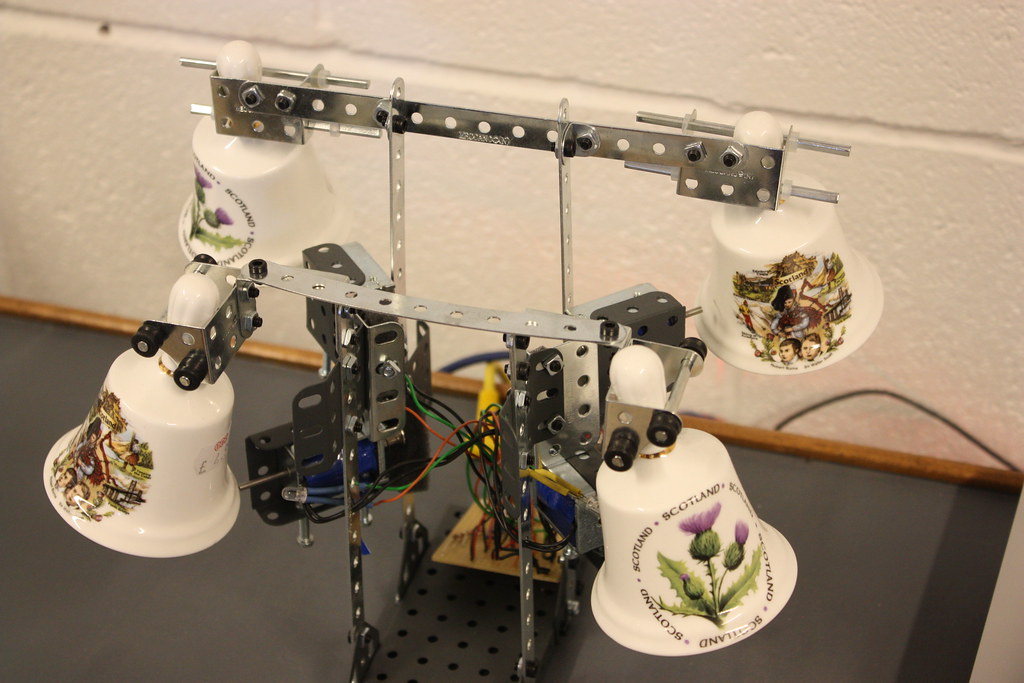
Twitter-triggered bells. They chimed whenever #chscot was tweeted. This led to underhand tweeting late into the first night to wind up early hackers…
My contribution this year is a team collaboration with Akiko Koyabashi and Brian Macdonald. We have been working with the Albert Drive data, a series of tweets about the Tramway’s fantastic sounding year-long community participation arts project all based in and around Albert Drive, Glasgow.
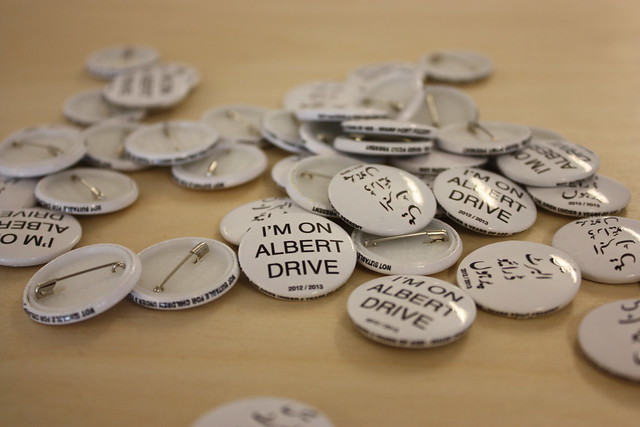
I Am on Albert Drive badges (in both English and Arabic)
When I looked at the data sets likely to be available Albert Drive caught my eye as I was keen to do something visual with the tweets – and started off with a plan to create an animation of the conversations back and forth. But, having packed any number of drawing, lego and stop motion kit things, inevitably, change. When I came to look through the data properly on Saturday morning it didn’t seem quite right for that format. A lot of the tweets were from the Albert Drive accounts (@AlbertDrive and @neighbourhoodw2) reporting the events as they happened. There were retweets and replies but overall the tweets (a 7 day snapshot from the project) are more reporting than conversation. They have also been provided with only minimal metadata and excluding georeferences – although it’s not all unusual for people to elect not to share their location on tweets (which is why mapped tweet visualisations should always ring a few feint alarm bells).
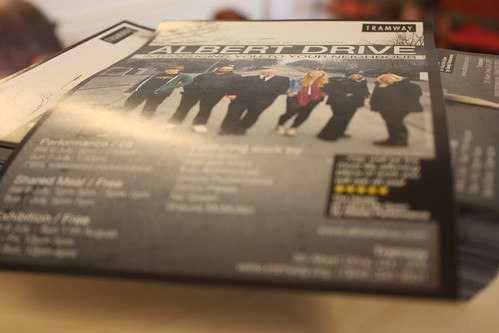
Flyers for Tramway’s Albert Drive project.
So, what to do? I started to read up more on Albert Drive and still thought the project was really interesting… I wanted to see if I could do something useful manually with the tweets perhaps… And then I was joined by Akiko, an Edinburgh-based architect who was keen to address Tramway’s core hope for Culture Hack Scotland: to have a lasting and impactful legacy for their project. Akiko was keen to do this through a physical presence of some sort and as we started chatting an idea began to come together. I would do something with getting those tweets on a map, locating them within their context. Akiko would design some form of awesome community-based physical experience/interface that would connect the real social world of Albert Drive to the archive of the Albert Drive project content. We both researched the project further, keen to find out what had happened in the arts project, how it had taken place, and how we could build on that.
I discovered that there was actually loads of additional content around the project – commissioned images, videos (shared across two youtube channels), tweeted images, sound clips… but lots of these were not connected up to the website and it was hard to browse or experience the project as a coherant whole. So I started pulling resources together. Meanwhile Akiko analysed the physical space of Albert Drive, it’s properties, character and key areas – she made this into a truly amazing Post It note wall.

My laptop showing Albert Drive tweets with Akiko’s amazing post it analysis shown in the background. Also pictured: a very tasty lunch.
As Akiko and I were chatting about possible physical embodiment, and key moments and locations associated with the project it became clear that getting ALL of these properly on the map would be a super starting point to understanding The Drive. So, much of my Saturday Night was spent manually building a layer of Albert Drive public spaces – the shops, the religious buildings, the post boxes, etc. This was a very manual process. Running two browsers in parallel I used Google Map Engine Lite to map each item, with Google Street Map open in parallel for reference, for checking the location and name of shops, etc. A fair amount of searching and verifying locations was also required but soon the map was coming together.
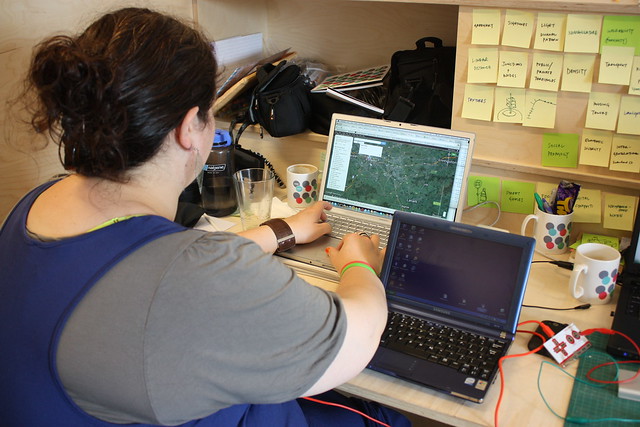
Me, hard at work finalising KML files for We Are On Albert Drive.
As I progressed the mapping Akiko designed several possible options for a physical embodiment of the project. Should it be a mobile seat? Perhaps a touch screen interface. Could the data be somehow projected into a more intimate space – she sketched a sort of comfy armchair with umbrella screen above it. Should a treasure box be used? I had seen simple physical interfaces like this at the new Furniture Gallery at the V&A and Akiko found a number of fascinating treasure box art works but thinking this through further the practicalities of curating content and maintaining it didn’t seem quite feasible for a project looking to create a lasting record rather than actively continuing. And then Akiko came across the notion of Guerilla benches and began prototyping some fantastic designs…
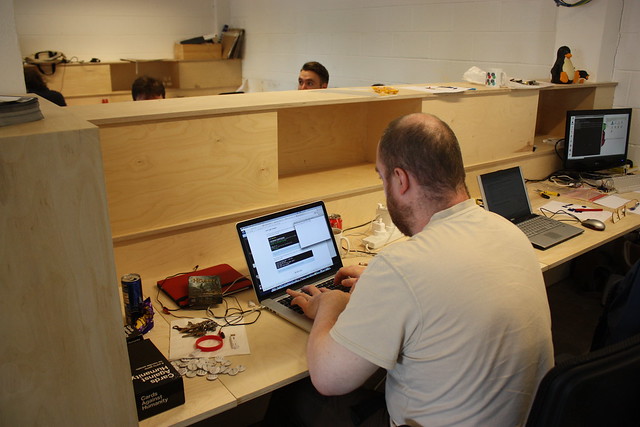
Brian codes into the night…
Meanwhile… early in the hack – in one of the check ins – Brian had said he was keen to do something on health and wellbeing that might look at the impact of the Albert Drive project but had hit a brick wall with the non-georeferenced tweets. He knew we’d been working with the same data and, when his own project seemed to reach a dead end, he came over to chat. It soon became clear that our public spaces map and Brian’s Twitter API work thus far could be a perfect combination. I exported the Public Spaces map as a KML and worked on pulling all of the videos and images around the project (again very manually) into a new map layer. Meanwhile Brian worked on how to turn this into a real experience – how to navigate and view content and start to pull in Tweets.
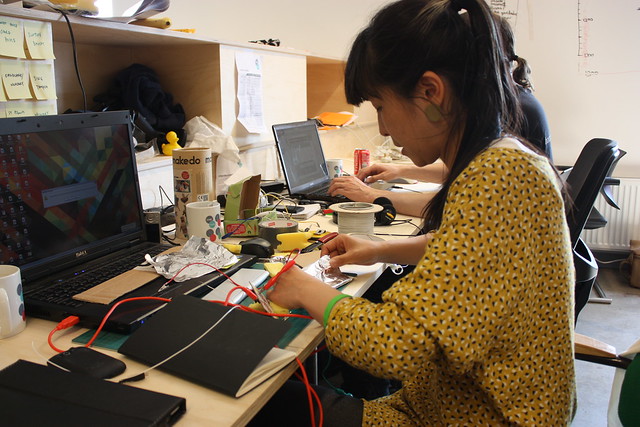
Akiko explores the potential of Makey Makey – a kit for turning anything vaguely conductive into a controller.
And working on the physical interface Akiko had, as we’d been foofing with the data, designed and begun construction on a fantastic sociable bench – you sit on it and view and navigate around the materials using very physical controllers running via the amazing Makey Makey human interface. The idea is for it to sit somewhere on Albert Drive – and be movable around various “guerilla” locations – and for conversations to start, for explorations of the project to be sociable and located.
Akiko worked on constructing the bench out of many layers of cardboard with clever Makedo parts (essentially reusable plastic construction parts) so that it was sturdy – and it was very study. She then commissioned the laser cutting folk to fabricate perforated screens for speakers, an acrylic sheet to use as a lightbox/projection screen, and plywood seat pieces which, via pressure pads, could trigger the bench to switch on/off.

Brian experiences a breakthrough moment as Akiko wires up the bench just before the hack deadline!
Things started to come together. In addition to the Public Spaces KML I had finished a reasonable cross section of the images, videos and sound recordings as a new Albert Drive KML. Finally I set to work creating a last crowd sourcable map layer. Anyone could add to this public Albert Drive layer enabling the community to add their own new materials – tweets, videos, comments, whatever – onto the map. Brian had created a simple-to-use walk through using Google Street Map but bringing in each of these layers. He envisioned adding live tweets as an additional layer – building on his previous work – and that would also have been in place had time allowed.
When we finally attached the Makey makey and a Pico projector to the laptop the effect was magical. Akiko had created four controllers – forward/back/left/right – using 10p coins that appeared to be glued to the acrylic panel. Making contact with them triggered you to walk through Brian’s map interface – which projected up from a pico projector concealed inside the box. As you walked getting near to the objects I had been mapping – a tweet, a photo, a video or a landmark – triggered it to appear in parallel with the map.

A map showing the Albert Drive tweets, images, video and sound objects I georeferenced for our hack.
OK there were a few bugs. I hadn’t managed to complete all objects on all of the layers and the crowdsource layer was more concept than content. Brian’s interface worked well but some object types weren’t happy – not all media embed codes are equal and working out the kinks wasn’t doable in the last hour. And Akiko’s bench was great but some of the physical controllers were more robust than others – in the end rather than use the pressure pad contacts we concealed the key earth connection in the perforated speaker housing as this was the only way to make a successful connection.
When it came time to demo our idea those loose connections and an overheating Pico projector let us down but Akiko did a great job explaining the concept. You can watch her presentation – and our collective attempts to fix the previously-beautifully functioning bench – in the video below:
Click here to view the embedded video.
You can also view Akiko’s slides – with some great mock ups of how the project would look in-situ – here: Albert Drive [PDF]
Whilst the demo didn’t go quite as planned we were able to show loads of our fellow hackers, arts organisations and interested others how the bench actually worked, with many delighted looks as people sat down, chatted, and proved how the sociable physical incarnation of the materials really added to the rich digital resources and fun 1st person map interface for them.
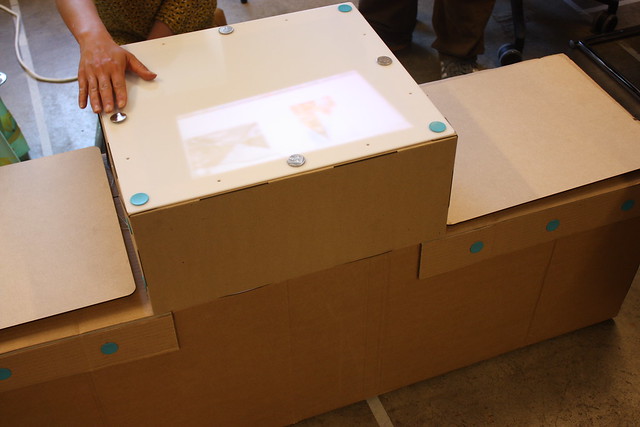
Akiko demonstrates the 10p controllers as the screen shows both the map and an image of one of the churchs on Albert Drive.
We were delighted at what we had created and felt honoured to be commended by Simon Kirby, Professor of Language Evolution, University of Edinburgh and one of the three Culture Hack Scotland 2013 judges.
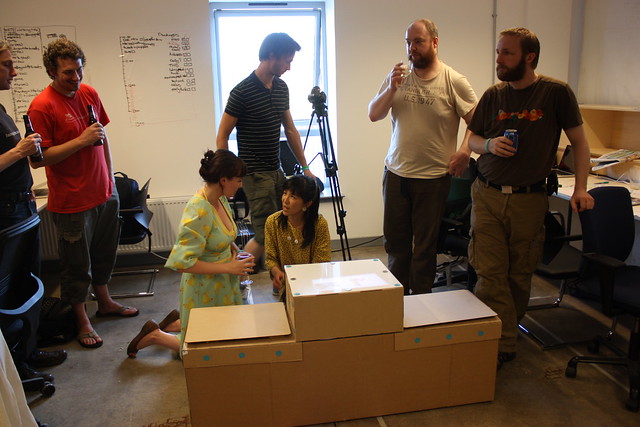
Tired hackers take a look at the We Are On Albert Drive bench being demonstrated when back up and running after our Show & Tell.
All three of us felt that the project needed to be local, relevant and alive. We each had different ways to do this. For Akiko that was about located and social experience, for me that was about getting a coherant path through the data based around geography, and for Brian it was about bringing in new and real time data in meaningful ways. It was a really inspiring team to be part of and I am really proud of what we all achieved in the time.
Huge thanks to Akiko and Brian for being just brilliant. Massive thanks are also due to the Tramway for inspiring our weekend with their date, and to the ever-amazing Culture Hack Scotland organisers at Sync for orchestrating another productive, creative, energising and inspiring Culture Hack!
- Official Albert Drive Project Website – the completely marvellous data set without which we would have had no hack at all! There are still events taking place in the project so do check out the programme and go along!
- Our Show & Tell presentation [PDF] – with huge thanks to Akiko for creating and presenting this!
- View the Albert Drive Map Layers here: https://mapsengine.google.com/map/edit?mid=zFJ1pl3CAxPU.krA1MKNxzy24 [KML download – viewable in Google Earth]
- View the Albert Drive Community Map Layer (and add to it) here: https://maps.google.com/maps/ms?msid=209448665323747409824.0004e17627da998e7bb04&msa=0 [KML download – viewable in Google Earth]
- Culture Hack Scotland website – home of the fantastic Sync team who put together this amazing event!
- We Are On Albert Drive hack write up on the CHS2013 website.
- My photos of team We Are On Albert Drive and other CHS sites.
Find our more about Team We Are Albert Drive:
- Brian McDonald is a Lecturer in Games Programming at Glasgow Caledonian University. Find out more on LinkedIn or follow him on Twitter: @BigBearScot
- Akiko Koyabashi is an Architect and Micro-Urbanist. She runs her own practice, Koyabashi Studio, based in Edinburgh. Find out more on LinkedIn or follow her on Twitter: @AkikoMaK
- Nicola Osborne (me) is EDINA Social Media Officer and teachs on the University of Edinburgh MSc in Science Communication and Public Engagement. Find out more on LinkedIn or follow her on Twitter: @suchprettyeyes.
And finally…
Please enjoy these highlights from others’ amazing Show and Tell demos:
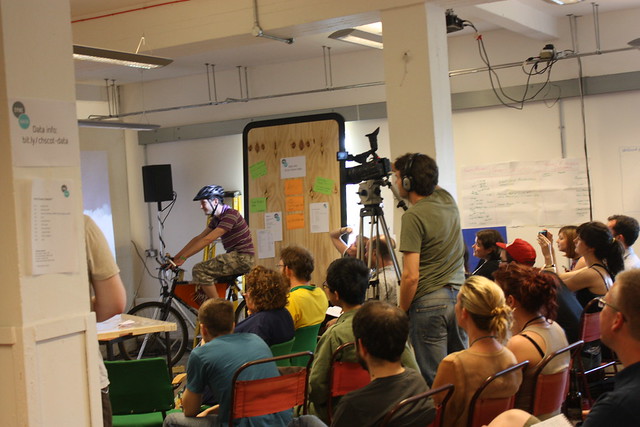
One of the hacks featured a bicycle wired up with sensors and Arduino to turn it into a controller for a video game – your cycling moves you around a skyscape where (in a more developed version) you would encounter birds flying.
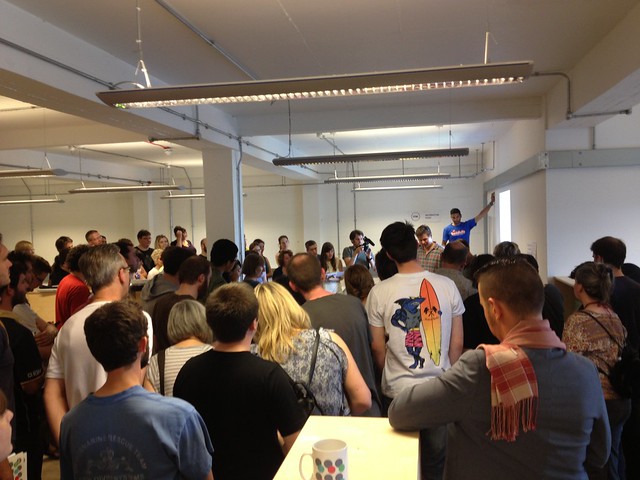
The full audience of hackers, arts organisations and judges pile into the hack space to view a sound map made of astroturf, cardboard, sensors and bird sounds. A highly interactive and popular hack.
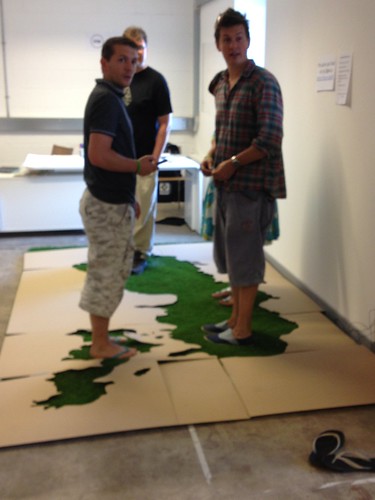
The map in action: you step to hear the bird population of that area, many people stepping creates a kind of avant garde bird song.
The full write up of the event can now be found on the Culture Hack Scotland website – I highly recommend a browse through each and every one of the imaginative hacks dreamed up during the weekend.
For a more nostalgia-inducing overview do also take a look at Live and Hacking – a Saturday-morning Kids TV-style streaming production entirely conceived, prepared, filmed and broadcast during the hack (where you will also see me on Tweet reporting duty).
